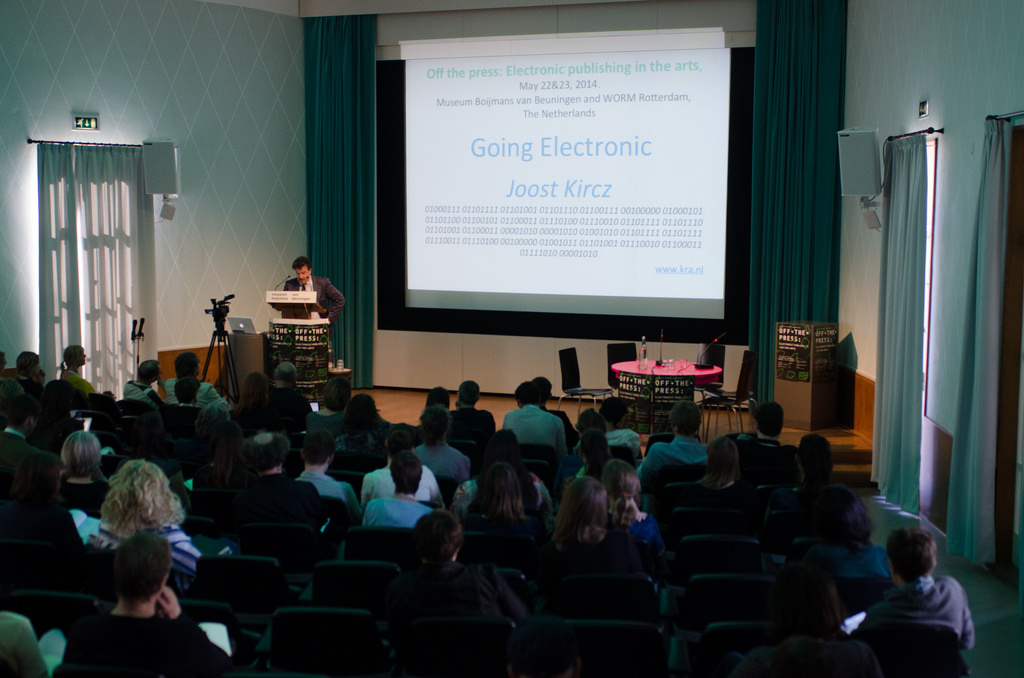A post by Mathijs Weijers
Joost Kircz was the first speaker of the 2-day conference “Off the Press – Electronic Publishing in the Arts”, organized by the Institute of Network Cultures. From 2006 till 2013, Kircz was a part-time lecturer on electronic publishing within the Amsterdam University of Applied Sciences (Hogeschool van Amsterdam), and currently he is involved with the Digital Publishing Toolkit research project. He regularly publishes his findings on his personal website, www.kra.nl.

Kircz’s presentation was about the various technical requirements and design standards that different types of electronic books need. “Electronic book publishing in the Arts is a multifarious adventure. On the one hand, electronic publishing is already an unclear notion and on the other hand the notion ‘Arts’ is something nobody agrees on anyway”, Kircz mused. He then introduced The Digital Publishing Toolkit, a project initiated by the Institute of Network Cultures in partnership with Knowledge Center Creating 010 of the Hogeschool van Rotterdam, and a number of publishers: “with this toolkit we want to be able to refrain from deep philosophical preoccupations and – as this conference will prove – are able to develop methods and techniques that help publishers, editors and authors to use electronic means to recreate old works and to create novel ones”. He argued that we must see Electronic Publishing as complimentary to print publishing and not just a change from paper-to-screen. What publishers need, and what the toolkit aims to provide, is easy to use, open source software (more about the Digital Publishing Toolkit, which is due to be release by the end of this year, can be read here).
Kircz argued that one of the most important features from the electronic medium is its active memory, “a memory that allows for endless reuse and multiple presentations on a great variety of substrates”. What he also pointed out is that content stored in an electronic memory cannot be read by humans. It is instead stored in a coded form: “(…) the most important conclusion we can draw from the fact that we use structured coded information as basis for book production, is that this demands new working methods throughout the whole process from author to reader. As soon as we take a step away from just a replication from the printed page, our design, our editorial practises, as well as our production and dissemination will change from bottom to top and back”, Kircz warned.
Different types of publishing materials might require different treatment. Kircz laid out four major toolkit scenarios:
1) Art/design catalogue;
2) Arts/designers book;
3) Research publication;
4) Art/design periodical.
Each kind of publication needs a different kind of approach in terms of use of metadata. What we read in a digital publication has much of this meta structure surrounding it, but we do not see it (i.e. a simple sentence like “ All you need is love” is in fact written in, for example, HTML code: <quotation> All you need is love </quotation>). This metadata can be used to specify and design almost any desired content and outcome but can also be complex to use.
What publishers need then is easy, readable software to work with. Kircz offered a short history of existing Mark-up Languages that address this need:
- SGML (1982) – which he described as the mother of all other coding languages;
- HTML 5 (most up-to-date ) – which is readable for humans;
- Epub3 (most up-to-date) – a competition to HTML5.
What the Digital Publishing Toolkit aims to do is add further resources, tools and software to this list and aid publishers in their e-publishing endeavours.
Kircz concluded that “(…) the central issue of our toolkit project is that we consciously try and define the creation, production, and consumption of a creative object as one single process. We try and experiment to create a production pipeline of illustrated texts or textually explicated collections of images in such a way that right from the beginning we understand, and appreciate that electronic publishing is more than reworking existing works, but a new creative branch in human expression.”
You can find a PDF of his original presentation here: Presentation Joost Kircz


